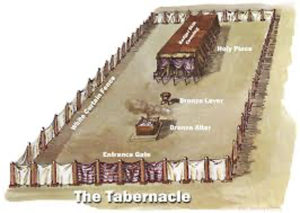

Terumah – Exodus 25:1-27:19

LA JOLLA, California — This parasha deals exclusively with orders (from God) for building the desert Tabernacle tent, including its contents and its immediate surrounding structures. Much detail is conveyed, despite which the reader remains puzzled as to how the construction could be achieved. Also, estimates of the amounts of materials prescribed suggest an unmanageable amount of weight to be carried about in the desert for 40 years. For example, it would have required one ton of gold, over three tons of silver, and 2-1/2 tons of bronze. The completed Ark alone would weigh an estimated minimum of five tons. The 48 acacia wood planks would each have weighed one-half ton. Additionally, the weight of various colored fabrics, precious stones, oils/ointments, containers, tables, and gold lamp-stand must have been considerable. [1]
My search of the internet for analogous orders from pagan gods to other ancient nations yielded nothing. This suggests that to date no sources have donated information in this realm to the internet. However, I found other sources: An early Sumerian inscription shows Gudea of Lagash (ca. 2300 BCE) receiving divine instruction for building a temple in Girsu. Materials included copper, willow-logs, ebony-logs, and abba-logs. [2]
Historically, there was also the pre-Islamic qubbah, which was a small portable tent shrine constructed of red leather. This suggests correspondence with red-dyed coverings in the Hebrew Tabernacle. The quabbah contained idols and cult objects. It was mounted on the back of a camel. When the tribe pitched camp, the tent shrine was unloaded and set up beside the tent of the sheik. People would come to it for oracles.
Similar portable shrines persist into current times, in the practices of Bedouins.
The layout of the Hebrew Tabernacle also corresponds to the layout of Rameses II’s (1290-1224 BC) oblong military camp, with nearly identical dimensions. It contained his tent, with sacred objects in the center. In fact, the construction technique employed in the Hebrew Tabernacle can be traced back to at least the middle of the third millennium BCE. The tomb at Giza of Queen Hetepheres of the Fourth Dynasty yielded wooden frames and beams equipped with hooks for the hangings to form a large canopy. Together with these was a wooden box overlaid with gold foil, perhaps analogous to the Hebrews’ Ark box which housed the stone-inscribed Ten commandments, as well as gold-cased furniture. The queen’s bed had a detachable footboard and a silver headrest.
It should also be mentioned that the Babylonian creation epic (Enuma elish) contains resemblances, when it ascribes the building of Marduk’s Temple in Babylon. In that story, the construction chores were done by the gods themselves.
Egyptian religious thought has similar details. Egypt’s physical sanctuary was alleged to be an extension of a mythical prototype on the same locality. The temple of Re at Heliopolis was said to have been planned by the god Thoth, the divine scribe.
Of course, unlike the above examples, the Hebrew Tabernacle clearly had a monotheistic religious significance, in communication with and obedience to a moral God. [3]
Above is the layout of the Biblical Tabernacle, analogous to the aforementioned Rameses II camp.
*
[1] Sarna, N., Exploring Exodus, Schocken Books, 1987, pp. 196-7
[2] Plaut, W.G., The Torah, A Modern Commentary, UAHC, 1981, p. 67
[3] Sarna, pp. 198-202
*
Irv Jacobs is a retired medical doctor who delights in Torah analysis. He often delivers a drosh at Congregation Beth El in La Jolla, and at his chavurah.